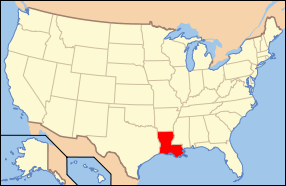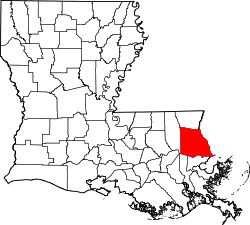Covington, Louisiana
| Covington, Louisiana | |
| City | |
 St. Tammany Parish Justice Center | |
| Country | United States |
|---|---|
| State | Louisiana |
| Parish | St. Tammany |
| Elevation | 26 ft (7.9 m) |
| Coordinates | 30°28′44″N 90°06′15″W / 30.47889°N 90.10417°WCoordinates: 30°28′44″N 90°06′15″W / 30.47889°N 90.10417°W |
| Area | 8.2 sq mi (21.2 km2) |
| - land | 8.0 sq mi (21 km2) |
| - water | 0.2 sq mi (1 km2), 2.44% |
| Population | 8,765 (2010) |
| Density | 1,068.9/sq mi (412.7/km2) |
| Founded | 1813 |
| Mayor | Mike Cooper |
| Timezone | CST (UTC-6) |
| - summer (DST) | CDT (UTC-5) |
| ZIP codes | 70433, 70434, 70435 |
| Area code | 985 |
|
Location of Covington in Louisiana
| |
 Location of Louisiana in the United States
| |
| Website: http://www.covla.com | |

Covington is a city in and the parish seat of St. Tammany Parish, Louisiana, United States.[1] The population was 8,765 at the 2010 census.[2] It is located at a fork of the Bogue Falaya and the Tchefuncte River.
Covington is part of the New Orleans–Metairie–Kenner Metropolitan Statistical Area.
History

The earliest known settlement by Europeans in the area was in 1800 by Jacques Drieux. In 1813, John Wharton Collins established a town there with the name of Wharton. He is buried on the corner of the city cemetery directly across from the Covington Police Department. There are conflicting stories about how the city came to be named Covington. Many historians believe the city was renamed after General Leonard Covington, a hero of the War of 1812.[3][4] However, local historian Judge Steve Ellis floats another theory centered on the suggestion by Jesse Jones, a local attorney, that the city be named in honor of the Blue Grass whiskey---made in Covington, Kentucky---enjoyed by town officials.[5]
In any case, Leonard Covington is the namesake of both towns.[4] Initially, commerce was brought to Covington via boat up the Bogue Falaya River, which used the Tchefuncte River as a means of passage to and from Lake Pontchartrain. Then in 1888, the railroad came to town. Much of those rails are now occupied by the Tammany Trace, a thirty-one mile bike trail running through multiple cities north of Lake Pontchartrain.
In the late 20th century, with the expansion of Louisiana's road system, many people who worked in New Orleans started living in Covington, commuting to work via the Lake Pontchartrain Causeway. This is considered to be associated with white flight out of New Orleans, though the Jefferson Parish area saw the most expansion during that period.[6]
Hurricane Katrina
Hurricane Katrina made landfall near Slidell, but Covington was sufficiently elevated to escape the massive storm surge; however, the city suffered devastating wind damage. Following the storm, Covington, along with the rest of the North Shore of Lake Pontchartrain, experienced a population boom as a result of many former inhabitants of the New Orleans area being forced to move out of their storm-ravaged homes. The town's population continues to grow.
Geography
Covington is located at 30°28′44″N 90°6′15″W / 30.47889°N 90.10417°W (30.479002, -90.104029)[7] and has an elevation of 26 feet (7.9 m).[8]
According to the United States Census Bureau, the city has a total area of 8.2 square miles (21.2 km2), of which 8.0 square miles (20.7 km2) is land and 0.23 square miles (0.6 km2), or 2.60%, is water.[9]
Demographics
| Historical population | |||
|---|---|---|---|
| Census | Pop. | %± | |
| 1870 | 585 | — | |
| 1880 | 567 | −3.1% | |
| 1890 | 976 | 72.1% | |
| 1900 | 1,205 | 23.5% | |
| 1910 | 2,601 | 115.9% | |
| 1920 | 2,942 | 13.1% | |
| 1930 | 3,208 | 9.0% | |
| 1940 | 4,123 | 28.5% | |
| 1950 | 5,113 | 24.0% | |
| 1960 | 6,754 | 32.1% | |
| 1970 | 7,170 | 6.2% | |
| 1980 | 7,892 | 10.1% | |
| 1990 | 7,691 | −2.5% | |
| 2000 | 8,483 | 10.3% | |
| 2010 | 8,765 | 3.3% | |
| Est. 2015 | 9,928 | [10] | 13.3% |
As of the census[12] of 2000, there were 8,483 people, 3,258 households, and 2,212 families residing in the city. The population density was 1,248.0 people per square mile (481.7/km²). There were 3,565 housing units at an average density of 524.5 per square mile (202.4/km²). The racial makeup of the city was 77.45% White, 20.17% African American, 0.33% Native American, 0.34% Asian, 0.04% Pacific Islander, 0.25% from other races, and 1.43% from two or more races. Hispanic or Latino of any race were 1.56% of the population.
There were 3,258 households out of which 33.8% had children under the age of 18 living with them, 46.8% were married couples living together, 17.2% had a female householder with no husband present, and 32.1% were non-families. 27.5% of all households were made up of individuals and 9.9% had someone living alone who was 65 years of age or older. The average household size was 2.52 and the average family size was 3.10.
In the city the population was spread out with 26.8% under the age of 18, 8.5% from 18 to 24, 26.1% from 25 to 44, 24.1% from 45 to 64, and 14.5% who were 65 years of age or older. The median age was 38 years. For every 100 females there were 86.8 males. For every 100 females age 18 and over, there were 80.0 males.
The median income for a household in the city was $36,949, and the median income for a family was $50,332. Males had a median income of $36,434 versus $23,859 for females. The per capita income for the city was $21,438. About 11.8% of families and 16.1% of the population were below the poverty line, including 23.5% of those under age 18 and 17.2% of those age 65 or over.
Points of interest
A 10-foot-tall (3.0 m) statue of Ronald Reagan on a 6-foot (1.8 m) base is reputed to be the world's largest of the former president.[13]
The Covington Trailhead is the start of Tammany Trace, a 31-mile paved trail for hikers and bicyclists, which connects Covington with Mandeville, Abita Springs, and Lacombe.[14]
Notable people
- Ernest Angelo, Texas oilman and Republican politician, reared in Covington
- Peggy Dow (Peggy Varnadow Helmerich), film actress and philanthropist, lived much of her childhood in Covington
- Brian Edwards, talent producer and author, grew up in Covington
- Greta Valenti, Television Producer for the Viacom series Live From Daryl's House with Daryl Hall from Hall & Oates, Creative Director and CEO of Grow Vision Studios, and musician and lead singer of the Alt Rock Trio Well Hung Heart. She grew up in Covington and went to Covington High School.
- Frank Burton Ellis, state senator (1940–1944), U.S. District Court judge, 1962–1965
- Dave Fortman, guitarist for the band Ugly Kid Joe and current American music producer, graduated from Covington High School
- Elizabeth Futral, opera soprano reared in Covington. Her father was minister of the Covington First Baptist Church for many years.
- Robert Higgs, prominent American economist, currently resides in Covington
- Blanche Long, First Lady of Louisiana 1939–1940, 1948–1952, and 1956–1960, born in Covington in 1902
- "Pistol" Pete Maravich, NBA all-star, lived in Covington until his death in 1988
- Walker Percy, author and essayist, lived in Covington until his death in 1990
- Harry Reeks, landscape painter and combat artist for the U.S. Marine Corps.[15]
- Amy Serrano, filmmaker, poet, essayist, and humanitarian
- Amanda Shaw, Cajun fiddler, singer, and actress
- Ian Somerhalder, actor and model, born in Covington
- Stephen Stills, musician best known for his work with Buffalo Springfield and Crosby, Stills, Nash & Young. Lived in Covington as a child.
- Hank Stram, NFL Hall of Fame Super Bowl Coach. Lived in Covington until his death in July 2005
- Michael G. Strain, veterinarian, Republican politician and current Commissioner of the Louisiana Department of Agriculture and Forestry.
- Lauren Turner, singer/songwriter, American Idol contestant season 10, graduated from Covington High School
Movies filmed in Covington
- 1995 — Dead Man Walking
- 1995 — Kingfish: A Story of Huey Long
- 1997 — Kasi Lemmons' Eve's Bayou
- 2005 — Local Color
- 2008 — The Yellow Handkerchief
- 2009 — I Love You Phillip Morris
- 2010 — The Pregnancy Pact
- 2012 — The Lucky One
- 2013 — Beautiful Creatures
- 2014 — American Ultra [16]
- 2015 — Joe Dirt 2
References
- ↑ "Find a County". National Association of Counties. Archived from the original on May 31, 2011. Retrieved 2011-06-07.
- ↑ "Profile of General Population and Housing Characteristics: 2010 Demographic Profile Data (DP-1): Covington city, Louisiana". U.S. Census Bureau, American Factfinder. Archived from the original on September 11, 2013. Retrieved February 17, 2012.
- ↑ Louisiana Department of Culture, Recreation and Tourism. "Covington Historical Marker".
- 1 2 Leeper, Clare D'Artois (2012). Louisiana Place Names: Popular, Unusual, and Forgotten Stories of Towns, Cities, Plantations, Bayous, and Even Some Cemeteries. LSU Press. p. 75. ISBN 978-0-8071-4740-5.
- ↑ City of Covington (Homepage). "History of the City of Covington".
- ↑ Greater New Orleans Community Data Center. "White Flight".
- ↑ "US Gazetteer files: 2010, 2000, and 1990". United States Census Bureau. 2011-02-12. Retrieved 2011-04-23.
- ↑ "US Board on Geographic Names". United States Geological Survey. 2007-10-25. Retrieved 2008-01-31.
- ↑ "Geographic Identifiers: 2010 Demographic Profile Data (G001): Covington city, Louisiana". U.S. Census Bureau, American Factfinder. Archived from the original on September 11, 2013. Retrieved February 17, 2012.
- ↑ "Annual Estimates of the Resident Population for Incorporated Places: April 1, 2010 to July 1, 2015". Retrieved July 2, 2016.
- ↑ "Census of Population and Housing". Census.gov. Archived from the original on May 11, 2015. Retrieved June 4, 2015.
- ↑ "American FactFinder". United States Census Bureau. Archived from the original on September 11, 2013. Retrieved 2008-01-31.
- ↑ http://www.roadsideamerica.com/story/18405
- ↑ "Things to do in Covington". 1stLake.com. Retrieved 17 March 2015.
- ↑ Bellande, Ray L. "Harry Del Reeks (1920 - 1982)". Ocean Springs Archives. Retrieved February 2014. Check date values in:
|access-date=(help) - ↑ "American Ultra". Backstage. Retrieved September 2014. Check date values in:
|access-date=(help)
External links
| Wikimedia Commons has media related to Covington, Louisiana. |
